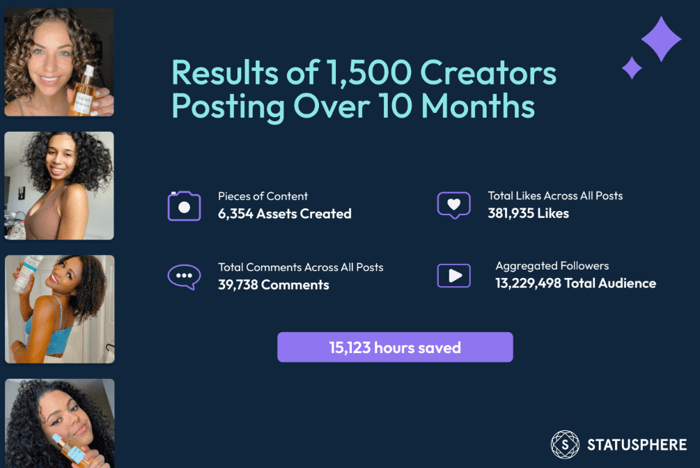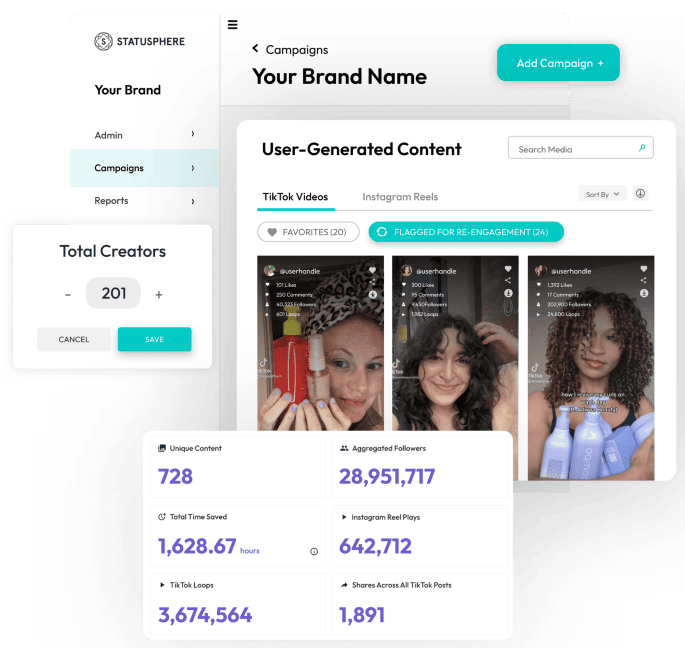Why Always-On Influencer Marketing is So Effective for Brands
Adopting an always-on influencer marketing strategy is key to better campaign ROI. This post explains why influencer campaigns shouldn’t be one-hit...
Picking the right length for an influencer campaign timeline can be tricky. Our guide is here to tell you how long to run a campaign if you want to see the best results.


“How long should an influencer marketing campaign last?”
This is a question we get asked all the time.
It’s no secret that influencer campaigns are a must-do for consumer brands. If you're already partnering with creators, it's safe to say you're on the right track.
But the tricky part is determining your influencer campaign timelines and "optimal" duration.
Like with any marketing campaign, you should maximize your time and cash spent. Managing influencers involves a lot of moving pieces which makes the question of duration complicated.
We’ve worked with thousands of creators and know firsthand how long it takes to see results from an influencer campaign. Below we break down expectations and tips for managing your timeline.
First thing’s first: there’s no magic number for how long influencer campaigns should be.
Like any marketing channel, you have to invest long enough to test and optimize before seeing results. Maximum results mean momentum and time.
Brands that see legitimate results view influencers as part of their holistic marketing strategy and not a quick blip on the radar.
The biggest mistake we see? Brands not committing enough time to see results at all.
Throwing money at any tactic and expecting instant returns will result in disappointment. Influencer campaigns are no exception.
Based on what we’ve seen firsthand, an “always-on” influencer strategy is best for brands.
Consider that 77% of brands have a dedicated influencer budget. This high level of commitment isn’t a reflex — it’s a long-term investment.
Think about marketing channels like SEO or inbound that are ongoing. These tactics require an upfront time and fine-tuning once in progress. Similarly, creator campaigns typically see steady growth before they scale to their full potential.
If your campaigns are always-on, you keep positive results rolling in for the long term. This includes ongoing influencer content, social proof and support for your sales efforts.
The takeaway? Approaching influencers as you would your inbound or ad strategies.
If your efforts are paying off and generating quality leads, you don’t slow down. Instead, you keep the momentum going. Apply the same school of thought to your influencer campaigns.
With any ongoing marketing tactic, you have big-picture goals broken up into smaller campaigns.
Let’s say your goal is to build brand awareness and increase your share of voice on Instagram. Then, consider the individual influencer campaigns needed to support your goals.
For example, one month you might promote a product launch on Instagram. The next month you might run an Instagram giveaway featuring creators. Then, you might run a multi-month user-generated content campaign to source reviews of your product.
Over time, these campaigns build upon each other. As content rolls in, you can reassess your strategy based on goals and results.
Here’s a sample influencer campaign timeline that’s common among the brands we work with:
“Influencer marketing is part art, part science,” Kate Milton, VP of Customer Success at Statusphere points out. “If you want to see immediate purchases but haven’t built enough brand awareness for your creators and their audiences, you’re going to need a high volume of content to make it happen.”
We’ll bite: it’s easy for us to say that long-term campaigns are best.
But there’s a reason why businesses that work with influencers aren’t on-again, off-again.
Notice how short-term influencer promotions are pretty rare among brands? Here’s why:
The shorter your campaign, the smaller your potential results. This includes potential pieces of content earned and how many people you can reach.
The more you invest, the bigger the payoff. The less you invest… you get where we’re going with this.
We’ve done the math: it takes ~70 hours to earn 30 influencer posts with a product gifting campaign. Given the time involved, brands won't see maximum ROI on a short-term campaign basis. Like many marketing initiatives, investing too little can cost you – in some cases by gains of 50%.
Again, influencer marketing should be an investment in your annual marketing plan.
Most brands dedicate between 10% and 20% of their marketing budgets to creator campaigns but that number is rapidly rising.
If you can’t invest at that level quite yet, just be sure to adjust your expectations accordingly. Short-term gifting campaigns with a handful of creators can yield results, though maybe not the ones you might expect.
Here’s what you could get out of a short-term campaign:
And here’s what you shouldn’t expect (particularly with less time and only a handful of influencers):
That said, you should aim for always-on campaigns because that’s where the real value lies.
We recommend kicking campaigns off with a minimum 90-day initiative to establish a foundation for growth. This is your sort of “testing phase” to experiment and gather data. After those first three months, you can make changes to your strategy based on your initial results and scale accordingly.
Below is a snapshot of how to approach your influencer marketing campaigns as they scale.
Important: these timelines assume that you're doing the bulk of the legwork yourself rather than relying on an influencer platform to do the heavy lifting related to your campaigns.
“If your main goal is brand awareness, an ‘always-on’ approach is optimal,” says Kate. “That means you engage and promote influencer posts consistently throughout the year.”
| "Always-On" Goals | "Always-On" Results |
|
|
Chances are you’re starting to see the pattern here: more time means more benefits.
Longer-term campaigns are more likely to help you achieve meaningful results. This includes reaching the largest possible audience, turning influencers into brand advocates and optimizing your ads. This includes running creator content as ads through whitelisting on Instagram and TikTok.
Again, influencer marketing represents an investment that can touch your entire marketing funnel. If you’re banking on short-term results without putting in the legwork, you’re going to be disappointed.
If you have a compelling product, vetted influencers and a vision for your campaign, you’re going to set yourself up for success long-term.
Brands that use Statusphere's software tick the boxes above by partnering with relevant influencers from our vetted creator community. Using 250+ unique, first-party data points, we match brands with influencers to earn guaranteed content at scale.
Don’t just take our word for it, either. Check out the results Curlsmith saw from their 10-month creator campaign with Statusphere. With 400,000+ interactions and over 13 million people reached, these numbers highlight the power of playing the long game.

“Influencer marketing is a long-term play,” notes Kate. “The best influencers tell a story. They provide value and get customers excited. With short-term campaigns, you likely won’t have enough time to build toward these goals.”
The short answer? It depends!
Building awareness and driving sales take time. Despite what critics say, it doesn’t take forever.
And as the saying goes, good things come to those who wait.
(However, you can speed up the process by earning hundreds of guaranteed posts with our platform!)
If you’re looking for a flood of leads as soon as influencers post, you need to rethink your expectations. Influencer campaigns are apples and oranges to conversion campaigns on TikTok or Instagram.
Note that influencer marketing campaigns often experience a sort of snowball effect when it comes to results and engagement. Once your creators and their content start picking up momentum, positive results soon follow.
Imagine how different Curlsmith’s campaign would have been if it had been limited to two or three months versus ten. It pays to be patient!
And while influencers can produce amazing results, they aren’t miracle workers!
If your current marketing strategy is underperforming or broken, don’t expect influencers to fix it by themselves. Remember: influencers are a piece of your overall marketing efforts. They aren’t a replacement for an actual strategy.
In terms of campaign results that you can see ASAP, consider the following metrics and KPIs that ramp up as your influencer content comes in:
“Once your influencers’ content is live, you’ll start to see engagement metrics tick up,” Kate says. “Don’t expect to dive into purchases and ROI metrics right away, though. Those can take longer to drive depending on your audience and content (TikTok videos versus IG Reels or Stories).”
If you want to see the positive impact of influencer marketing, be prepared to play the long game.
Because the more time you commit to your campaigns, the more results you’ll see. This includes repurposable influencer content, better rankings in social search and visibility with your target audience.
There’s no denying that scaling creator campaigns in-house requires a ton of legwork, though.
Again, that’s where Statusphere can help!

Our software streamlines and optimizes the most time-consuming tasks related to influencer marketing. This includes matchmaking, fulfillment, reporting and content rights management.
When all of the above are off your plate and in the hands of our expert-driven platform, you can see a notable ROI from influencer marketing faster.
Want to learn more about how our platform works? Chat with one of our experts to see how Statusphere can earn you authentic, rights-ready content at scale in a fraction of the time.
This article was first published in August 2022. It was last updated May 27, 2023.
Adopting an always-on influencer marketing strategy is key to better campaign ROI. This post explains why influencer campaigns shouldn’t be one-hit...
Want to scale your creator campaigns? Hiring an influencer marketing agency might seem like your next step. Below are eight key questions to ask...
When running your first influencer marketing campaign, setting realistic expectations is crucial. Below we explain what brands need to know to kick...
Be the first to know about the latest tools, trends and strategies in influencer marketing for brands.